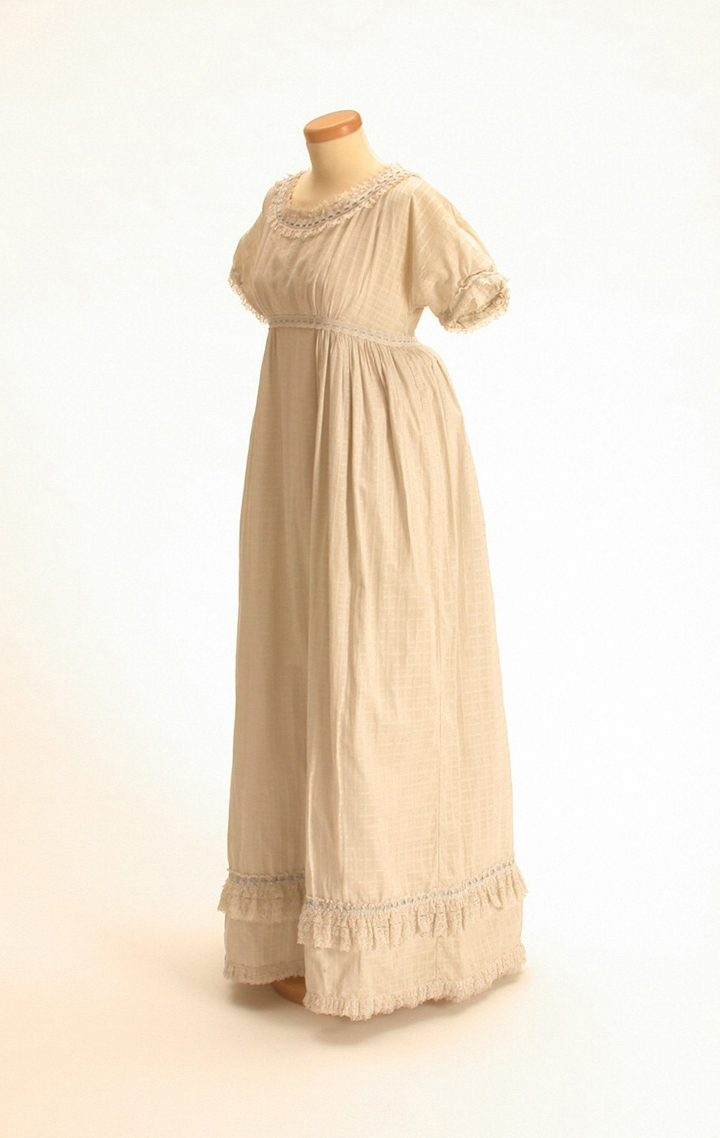Woman's Dress, Regency, Replica
By the end of the 18th century, elaborate clothing with many layers and petticoats had gone out of fashion. This was due in part to the French Revolution of 1789, which overthrew the monarchy and replaced the ornate clothes associated with it with much simpler and plainer clothing.
In France this type of dress was called a robe en chemise which was basically an undergarment as that is what the dresses looked like. When they were first introduced these dresses were made of muslin as it was the most simple fabric available. There are stories of women wetting their dresses in order to make them cling to their legs, and catching cold as a result.
At the beginning of the 19th century women's fashions began to be more decorative again but were still based on the simple designs, with high waists and long straight skirts. These were based on ancient Greek styles and were made in plain fabrics such as calico or linen. For evening wear or for court, clothes had the same shapes but were made of luxury fabrics such as velvet, silk or satin. In order to achieve freedom of movement and simplicity women had abandoned corsets, but they now returned to them, although waists did not come back into fashion for a while.
In France this type of dress was called a robe en chemise which was basically an undergarment as that is what the dresses looked like. When they were first introduced these dresses were made of muslin as it was the most simple fabric available. There are stories of women wetting their dresses in order to make them cling to their legs, and catching cold as a result.
At the beginning of the 19th century women's fashions began to be more decorative again but were still based on the simple designs, with high waists and long straight skirts. These were based on ancient Greek styles and were made in plain fabrics such as calico or linen. For evening wear or for court, clothes had the same shapes but were made of luxury fabrics such as velvet, silk or satin. In order to achieve freedom of movement and simplicity women had abandoned corsets, but they now returned to them, although waists did not come back into fashion for a while.



By the end of the 18th century, elaborate clothing with many layers and petticoats had gone out of fashion. This was due in part to the French Revolution of 1789, which overthrew the monarchy and replaced the ornate clothes associated with it with much simpler and plainer clothing.
In France this type of dress was called a robe en chemise which was basically an undergarment as that is what the dresses looked like. When they were first introduced these dresses were made of muslin as it was the most simple fabric available. There are stories of women wetting their dresses in order to make them cling to their legs, and catching cold as a result.
At the beginning of the 19th century women's fashions began to be more decorative again but were still based on the simple designs, with high waists and long straight skirts. These were based on ancient Greek styles and were made in plain fabrics such as calico or linen. For evening wear or for court, clothes had the same shapes but were made of luxury fabrics such as velvet, silk or satin. In order to achieve freedom of movement and simplicity women had abandoned corsets, but they now returned to them, although waists did not come back into fashion for a while.
In France this type of dress was called a robe en chemise which was basically an undergarment as that is what the dresses looked like. When they were first introduced these dresses were made of muslin as it was the most simple fabric available. There are stories of women wetting their dresses in order to make them cling to their legs, and catching cold as a result.
At the beginning of the 19th century women's fashions began to be more decorative again but were still based on the simple designs, with high waists and long straight skirts. These were based on ancient Greek styles and were made in plain fabrics such as calico or linen. For evening wear or for court, clothes had the same shapes but were made of luxury fabrics such as velvet, silk or satin. In order to achieve freedom of movement and simplicity women had abandoned corsets, but they now returned to them, although waists did not come back into fashion for a while.




















